in the United States: Discipline and Photographs, The Prison Experience (1999)
by James R. Hugunin
II
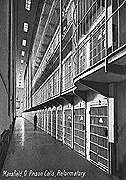
Cellblock,
Mansfield
Reformatory,
England
This book is neither a historical investigation per se, nor a polemic for a monolithic theoretical position; semiotic and psychoanalytic approaches are com-bined; the terrain of subjectivity as conscious and unconscious becomes a zone where the subject is not merely an effect of structure, but a subject, individual, implicated in the production of meaning. Simon During's remarks in his "Introduction" to The Cultural Studies Reader (1993) on this point of structure and agency bear citing at length:
". . . in theory at least, individuals can always make choices which take into account, and thus avoid, the forces they know to be positioning them. Also, because human beings exist as "embodied social subjects" (as Teresa de Lauretis puts it in her essay in this volume), an individual's relation to the fields continually incorporates and shifts under the impact of contingent givens (skin color, physical appearance, and so on) and material events (illness, technological break-downs, and so on) which are not simply determinants of social or cultural forces. Third, language itself intervenes between the indi-vidual and the socio-cultural fields that construct his or her positions. Our sense of uniqueness is grounded on our sense that we can say what we like — at least to ourselves — and we have that sense because language is both a resource that costs nothing . . . and complex enough to enable an infinite number of individual speech acts."
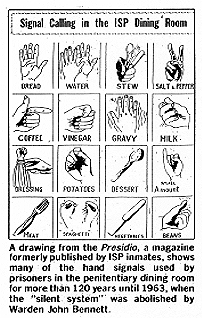
Iowa
State Penitentiary inmate hand signals
used
in the prison dining room up until 1963.
Philosopher Don Ihde put it elegantly, "Language and experience must be dealt with together as the paired foci of the single ellipse of subjectivity." Thus, subjects are constituted discursively; experience is understood to be a linguistic event such that it doesn't occur outside established meanings, yet neither is it confined to a fixed order of meaning. As discourse is shared, is dialogic, experience is collective, as well as individual, "in which the otherness of each interacting participant remains intact."
In theorizing this razor's edge between structure and agency, I utilize insights drawn from Michel Foucault's study of prisons and punishment and feminist film theorist Laura Mulvey's examination of the psychological economy of representation. But I also draw deeply from British sociologist Anthony Giddens's and feminist film theorist Teresa de Lauretis's theoretical program to empower a new type of mobile subject. This "nomadic" subject draws upon a complex of habits resulting from the semiotic interaction of outer-world and inner-world, the continuous engagement of a self or subject in social reality. This is what Giddens understands as "duality of structure" and what De Lauretis terms "experience," a process of "self analyzing." Giddens key proposal is that "the notions of action and structure presuppose one another."
Giddens's theory of structure as both enabling and constraining was anticipated by Jean-Paul Sartre in The Critique of Dialectical Reason (1960). Therein, Sartre notes that social structure, once interiorized, constrains and liberates at the same time; he refers to such a structure as composed of "contradictory tensions of freedom and inertia," and notes that "the double character of structure (an inert object of calculation when seen as ossature without taking account of totalization, or an effective power actualized by the praxis of each and all) implies a double character in the idea." He concludes that "We will therefore call these structures, insofar as their inorganic materiality has been freely interiorized and reworked by the group, the necessity of freedom."
De Lauretis, recalling Sartre, also mutually implicates structure and agency to arrive at her notion of experience, "Experience is the process by which, for all social beings, subjectivity is constructed. Through that process one places oneself or is placed in social reality and so perceives and comprehends as subjective (referring to, originating in oneself) those relations—material, economic, and interpersonal — which are in fact social, and, in a larger perspective, historical." These two thinkers (who have more in common than one might suppose) are used as a theoretical balance to Louis Althusser's, Michel Foucault's and (to a certain extent) John Tagg's tendency to monologically disperse the agent into an effect of the social structure. Moreover, De Lauretis's attempt to think beyond the limitations of using either a semiotic or a psychoanalytic perspective in relationship to the problem of narrative informs my concluding analysis of enabling and disabling carceral narratives, narratives in which the issues of photographic representation — as pertaining to realism, evidential value, artifice, honorific concern, and instrumentality — are the middle chapters' main topics.
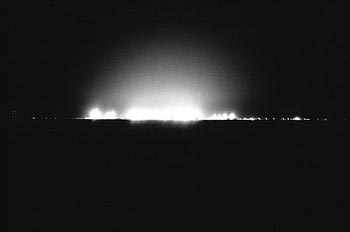
Prison,
Delano, CA (gelatin silver print, 20 x 24 inches,
1996)
![]() copyright 1996 by Stephen Tourlentes
copyright 1996 by Stephen Tourlentes

California
Medical Facility, Vacaville, CA, April 1997 (gelatin silver print,
8 x 10 inches)
![]() copyright 1997 by Herman Krieger
copyright 1997 by Herman Krieger
It was necessary for those unfamiliar with penal history to contextualize the critical discussion with a summarizing glance at the penitentiary — and, hence, the notions of punishment and rehabilitation — as that institution developed out of the confluence of a variety of discourses. Even though these sources can be traced back to Catholic monasticism and the experience of the Black slave experience in the United States, my discussion segues into the nineteenth century's developing tech-nologies of social definition and control as related to photography as theorized in John Tagg's "Power and Photography, Part One, A Means of Surveillance: The Photograph as Evidence in Law" (1980), Elissa Gelfand's Imagination in Confinement (1983), Allan Sekula's article "The Body and the Archive" (1986), and Maren Stange's Symbols of Ideal Life (1989). I then glance back at the eighteenth century with the assistance of Michael Ignatieff's A Just Measure of Pain (1989), Frank McLynn's Crime and Punishment in Eighteenth-Century England (1991), and John Bender's Imagining the Penitentiary (1987). I move into the twentieth century using Illinois's state penitentiary at Joliet-Stateville and Canada's Archambault and St. Vincent de Paul maximum security facilities as sites, culling insights from Michel Foucault's Discipline and Punish (1979) even as I question what I believe to be his disempowerment of the subject. Jacques Derrida's "logic of the supplement" as applied to his problematizing of the binary concepts of work/center and frame/ margin — what he terms ergon and parergon respectively — and is used specifically to explicate the photographer/ inmate photo/drawing collaborations orchestrated by Robert Saltzman in his series "La Pinta: Doing Time at Santa Fe" (1983-83). This body of work, along with Camhi's, exemplifies Foucault's understanding of the strategic nature of the apparatus he terms "Pouvoir/Savoir."
Besides subsuming carceral representation under the repressive, honorific, and ironic modes within these historical contexts and discursive fields, subplots are hatched. As already mentioned, a modernist versus postmodernist comparison spans chapters four and five wherein Lyon's modernist Conversations with the Dead is set against Camhi's postmodernist The Prison Experience. Chapter six contrasts Lyon's and Camhi's work against Bruce Jackson's Killing Time (1977), Ethan Hoffman and John McCoy's Concrete Mama: Prison Profiles from Walla Walla (1981), and Douglas Kent Hall's In Prison (1988).
As previously mentioned, chapter seven compares Glassman/Borofsky's modernist video tape on inmates at San Quentin with Stephen Roszell's "quasi-postmodernist" reversal of guard/prisoner roles — a video that sees guards as "other prisoners" — and with Jeanne C. Finley's radically postmodernist video on women in prison. Each chapter also interrogates the texts under discussion as to the "truth of sex" in the prison—I am indebted here to Foucault's The History of Sexuality (1980), to Laura Mulvey's insights, and to photographer-theorist Doug Ischar's essay "Endangered Alibis" (1990) on gay representation. I raise the issue of sexuality and prison (mainly as pertains to male prisoners) seeking to what extent and how sexuality (particularly homosexuality) has been represented, repressed, and exposed. I also explore how the prison (the "matrix") and the inmate (regardless of biological sex) is coded as "female" in relationship to the carceral (read "male") authority.
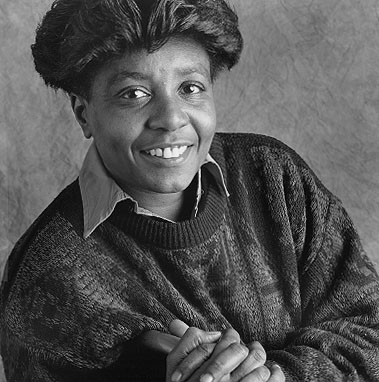
"Sharon Wiggins,"
from Doing Life: Reflections of Men
and Women Serving
Life Sentences (1996) Howard Zehr
In chapter eight, I treat of more recent efforts, such as Chicago photographer Lloyd DeGrane's photographs from Cook Country Jail, Joliet, and Stateville Prisons (1990-94). DeGrane's work has been published and exhibited in part in a variety of venues, but has not been collected into a single text. My main focus in this chapter is a comparison and contrast between Howard Zehr's Doing Life: Reflections of Men and Women Serving Life Sentences (1996) and Ken Light's Texas Death Row (1997). although Lou Jones's Final Exposure: Portraits from Death Row (1996) will be addressed as well. DeGrane's and Light's images contextualize the inmates within the horrors of the penitentiary using a "you-are-there" stark realism. Light and his collaborator, Suzanne Donovan, given the horrors perpetrated by condemned inmates, are ambivalent; although "perennial losers" (Donovan) the men deserve a more humane punishment than the "archaic form of justice" (Light) that is the death penalty. Zehr contrasts markedly in feelings toward the inmates and in photographic style used from both DeGrane's and Light and Donovan's efforts. This Mennonite prison-activist symbolically "paroles" Pennsylvania's "lifers" by taking their portraits before a plain backdrop, clad in street clothes. Devoid of their carceral context, with sincere and friendly faces, the inmates speak to us in lengthy transcriptions from audio-taped interviews. Unlike the diversity of voices and style of dress and pose seen in Camhi's book, unlike Light's introducing inmate rap sheets detailing vicious crimes, Zehr's effort shows a uniformity of visual style throughout, excludes the voices of victims, guards, and their spouses. His aim is reformist; it is clearly focused on influencing voters to replace Pennsylvania's no-parole life-terms with a more flexible mode of sentencing that reflects both mercy and the human potential for rehabilitation.
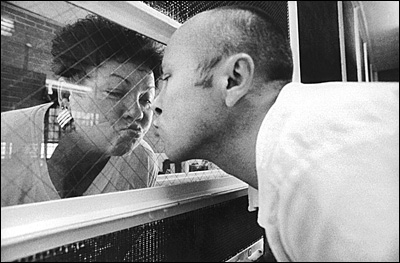
Mother
and Son Visiting, Texas Death Row (1994) Ken Light
![]() Ken
Light, from Texas Death
Row, University Press of Mississippi
Ken
Light, from Texas Death
Row, University Press of Mississippi
(1997);
to order this photo book call: 800-982-6371
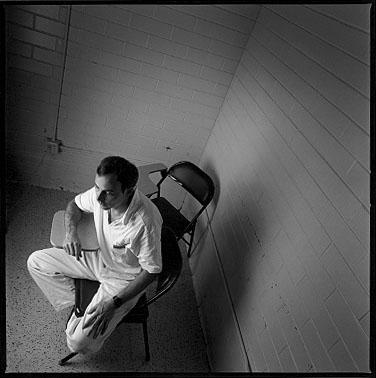
"James Vanderbilt,
Ellis I Unit, Huntsville, Texas" from Final
Exposure: Portraits
from Death Row (1996) Lou Jones
My Conclusion extends the analysis of narrative and agency/structure by examining the polysemous nature of texts — a text may be given a preferred, negotiated, or oppositional reading. Therefore, I argue that realism, narrative closure, and visual pleasure need not always serve the dominant ideology. Drawing upon Terence Turner, Teresa De Lauretis's and Paul Ricoeur's provocative challenge to the hardcore anti-narrativists, I argue for empowering narratives. I use these thinkers to reveal a mutual dependence within narrative analogous to Giddens's assertion about the mutual dependence of agency and structure. Within this context I discuss the controversial work of New Orleans video/book/installation artist Dawn Dedeaux. Her work, aiming to create a meaningful dialogue between Black gang members inside prison and those still out in the community, was temporarily confiscated by the FBI.
Although the individual works discussed are, more or less, treated in chronological order, the insertion of historical background is motivated by the immediate concerns of my analysis rather than considerations of chronological development. Primary sources for the history of the penitentiary are listed in the bibliography.
In summary, this study hopes to reconstitute a sense of the complexity of the carceral (as one aspect of the state's coercive apparatus/structure) as it functions physically, ideologically, and as an economy of desire. Concerning the latter, Stephen Pfohl and Avery Gordon—personifying the carceral master discourse as "he" and the criminal as "she" — describe the pleasures of criminology. They find them rooted in sadism (associated by Laura Mulvey with voyeurism) and surveillance (associated by Mulvey with fetishistic scopophilia):
"The pleasure of criminology is to displace the other's unfixed pleasure into the pain of a certain victim and to master her: to subject her to the rules of reason, just as he defines her, this exotic contrary fallen between the cracks. She is the criminologist's subject matter, this unreasonable savage other, dark and unruly. She is the object of his discipline and dangerous. He comes upon her at night in the city and enlightens. To master her, to reduce her to a thing he can count upon—this is the first pleasure of criminology. He says, "We need to penetrate the facts of this crime." This is the first pleasure of criminology: SADISM."The second pleasure of criminology involves the gaze. To keep an eye upon her, to classify, count and cut her up, to make her visible as a certain thing: to dissect that visibility into rates and measure her incidents; to map her determined figure and to analyze her probable path; to uncover everything about her and to lay her bare; to arrest her so that he may operate upon her and see what happens. This is the criminologist's principal method — to never let her escape from sight, to watch her constantly so as to know everything she is. . . . This is the second pleasure of criminology: SURVEILLANCE."
But this study also suggests the prison's potential to offer a site for alternative social, political, and aesthetic practices; that is, a productive site for representations of resistance and agency — graphic and/or verbal — by both those within and those outside its dehumanizing clutches. For as Pfohl and Gordon write, "He demanded her silence, but she resisted saying. What you call reason, I call sadism." For all of Foucault's emphasis on how the carceral regime positions its imprisoned subject, he does allow for the pleasure of resistance — albeit as a subsidiary of power, for nothing, he says, escapes the discourse of power/knowledge:
The pleasure that comes of exercising a power that questions, monitors, watches, spies, searches out, palpates, brings to light: and, on the other hand, the pleasure that kindles at having to evade this power, flee from it, fool it or travesty it. The power that lets itself be invaded by the pleasure it is pursuing: and opposite it, power asserting itself in the pleasures of showing off, scandalizing, resisting.
A pedagogical cum carceral example can be found in R. Hodge and D. Tripp's Children and Television. Therein, the authors note how Australian school children resistantly read the television program "Prisoner" (screened in the USA as "Prisoner: Cell Block H") in terms of their own "incarceration" in school, an environment that approximates what sociologist Erving Goffman calls "a total institution." The students studied by Hodge and Tripp perceived the following main similarities between prisons/inmates and schools/students:
"1) pupils are shut in; 2) pupils are separated from their friends; 3) pupils would not be there if they were not made to be; 4) pupils only work because they are punished if they do not, and it is less boring than doing nothing at all; 5) pupils have no rights: they can do nothing about an unfair teacher; 6) some teachers victimize their pupils; 7) there are gangs and leaders amongst the pupils; 8) there are silly rules which everyone tries to break."
The students also noted that there were strategies of resistance that applied to both forms of institutions. Prisoners/students both used a secret language of special words, nudges, winks, glances, and doubles entendres to communicate amongst themselves under the noses of, and in resistance to, the warders/teachers.
In this book, I have attempted to convey the variety and richness of such dissenting, marginal "voices" that speak out — in photographic images as well as words, offline and online — against the carceral regime's repressiveness as manifested in its "endless variety and monotonous similarity." With the exception of a brief discussion of Michael Quanne's art, inmate painting had not been discussed; the reader is encouraged to refer to Phyllis Kornfeld's Cellblock Visions: Prison Art in America (1997), and to Marian Liebman's anthology Art Therapy with Offenders (1994). It is regretted that not every photographic, filmic, and video depiction of prisons and prisoners could be discussed here. I do, however, want to mention in passing the video tape of the restored film documentary Attica (b&w and color, 80 minutes, 1971) by Cinda Firestone; the video Death Row Notebooks (1992) by Annie Goldson and Lamar Williams, which is structured around an interview with political prisoner Mumia Abu-Jamal on Death Row in Pennsylvania; the video Correcting Corrections, Part I: Crimes of Punishment and Part II: The CIA of Government (color, 30 minutes each section, 1993) which is an effort by artist Marshall Weber, and prison activists Glen and Jackie Austin of WI Cure Inc. in Madison, Wisconsin to reveal in-prison abuses to free-speech, AIDS prevention, race-relations, and so forth that put in question the mythic "progressive" nature of the Wisconsin's Department of Corrections; and, finally, Shut Down All Control Units (color, 30 minutes, 1994), a video produced by The Committee to End the Marion Lockdown in an effort to call attention to the horrific new regimen of solitude, silence, and electronic surveillance being experimented with in several recently built High-Security Units (HSU) in the United States.
Moreover, it is regretted also that not every one of the burgeoning websites by and for prisoners could be mentioned. These "virtual communities" fill a gap left by the demise of nearly all inmate-produced publications. They are efforts at pro-ducing a narrative space, a potential authoring site, where it is hoped textual circulation on the Net may recover political agency — turning text into tactic. Oliver Schmidtke identifies computer-mediated communication's (CMC) potential as a grassroots, democratic form of discourse: 1) it reduces costs for collective actors; 2) it reduces individuals' costs for engagement and participation; 3) it reduces intra-organizational hierarchy and intensifies the actors' sense of involvement; 4) it facilitates the formation of collective identity; 5) it is effective in suggesting the strength and prospects of a collective actor. The impact of CMC on the penal context will soon merit scholarship that brings together the topics of electronic media and the carceral regime. In sum, the textual and visual production in this field concerning the carceral is growing steadily and the topic itself is inexhaustible. My wish is that this study will encourage others to continue this investigation.